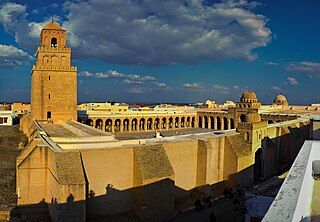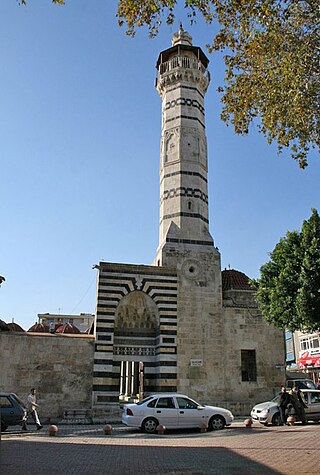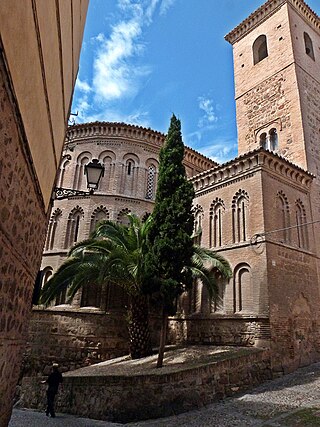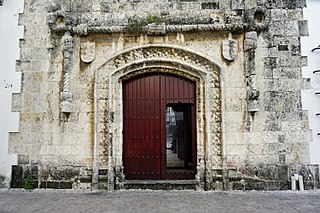
The Templar House in Toledo, is a residence in Castile-La Mancha, Spain. It was built and decorated between the years 1085 and 1114. [1]
The property was once owned by the Knights Templar, and founds use as a guest house in the 14th century. [2]

The Templar House in Toledo, is a residence in Castile-La Mancha, Spain. It was built and decorated between the years 1085 and 1114. [1]
The property was once owned by the Knights Templar, and founds use as a guest house in the 14th century. [2]
The most primitive elements of the whole are the remains of the hall of Caliphal time (10th century), located in the subsoil or basement, under the hall of the eastern wing. This hall has stucco walls and bicromo ornamentation, reminiscent of Mozarabic. It corresponds to an earlier state of the building, in which it would constitute the hall of the western wing of another courtyard located to its eastern side.
The ground floor is distributed around the courtyard. From the 11th–12th century the hall, the alcove and the upper chamber of the western wing are conserved, with its corresponding alfarje . It highlights the transformation of the entrance arch made of gemade of horseshoe taifa to have a Mudéjar yeseria , decorated with vegetal motifs. [2]
In the hall of the southern wing, the most important modification consists of the suppression of the lower part of the facade, to realize in yeseria gable door, flanked by two lion protomes and framed by double-arched stone, of slightly pointed horseshoe, which has two medallions with Castilian emblems. The ensemble is framed by a rectangular ornament (arrabá) with kufic legend inscribed, from the end of the 12th century or the beginning of the 13th century.
In front, occupying space that originally belonged to another room, a raised porch was added, with a terrace on the deck, made up of two factory masons (originally also covered with yeseria); They support a complex framework of carpentry, which imitates a thick beam, in which suras III and XLVIII of the Quran are partially carved. [2]

The Mosque–Cathedral of Córdoba, officially known by its ecclesiastical name of Cathedral of Our Lady of the Assumption, is the cathedral of the Roman Catholic Diocese of Córdoba dedicated to the Assumption of Mary and located in the Spanish region of Andalusia. Due to its status as a former mosque, it is also known as the Mezquita and as the Great Mosque of Córdoba.

The Convent of Christ is a former Catholic convent in Tomar, Portugal. Originally a 12th-century Templar stronghold, when the order was dissolved in the 14th century the Portuguese branch was turned into the Knights of the Order of Christ, that later supported Portugal's maritime discoveries of the 15th century. The convent and castle complex are a historic and cultural monument and was listed as a UNESCO World Heritage site in 1983.

The Alcázar of Seville, officially called Royal Alcázar of Seville, is a historic royal palace in Seville, Spain. It was formerly the site of the Islamic-era citadel of the city, begun in the 10th century and then developed into a larger palace complex by the Abbadid dynasty and the Almohads. After the Castilian conquest of the city in 1248, the site was progressively rebuilt and replaced by new palaces and gardens. Among the most important of these is a richly-decorated Mudéjar-style palace built by Pedro I during the 1360s.

The Great Mosque of Kairouan, also known as the Mosque of Uqba, is a mosque situated in the UNESCO World Heritage town of Kairouan, Tunisia and is one of the most impressive and largest Islamic monuments in North Africa.

Moorish architecture is a style within Islamic architecture which developed in the western Islamic world, including al-Andalus and what is now Morocco, Algeria, and Tunisia. Scholarly references on Islamic architecture often refer to this architectural tradition in terms such as architecture of the Islamic West or architecture of the Western Islamic lands. The use of the term "Moorish" comes from the historical Western European designation of the Muslim inhabitants of these regions as "Moors". Some references on Islamic art and architecture consider this term to be outdated or contested.

The Aljafería Palace is a fortified medieval palace built during the second half of the 11th century in the Taifa of Zaragoza in Al-Andalus, present day Zaragoza, Aragon, Spain. It was the residence of the Banu Hud dynasty during the era of Abu Jaffar Al-Muqtadir. The palace reflects the splendor attained by the Taifa of Zaragoza at its height. It currently houses the Cortes of the autonomous community of Aragon.

The Alcazaba is a palatial fortification in Málaga, Spain, built during the period of Muslim-ruled Al-Andalus. The current complex was begun in the 11th century and was modified or rebuilt multiple times up to the 14th century. It is one of the best-preserved alcazabas in Spain. The Alcazaba is also connected by a walled corridor to the higher Castle of Gibralfaro, and adjacent to the entrance of the Alcazaba are remnants of a Roman theatre dating to the 1st century AD.
Santa María de Melque is a church in the province of Toledo in Spain. It has been described as the biggest fully vaulted early medieval church still standing in Western Europe. It is located in the municipality of San Martín de Montalbán, equidistant from the towns of La Puebla de Montalbán and Gálvez, between the brook Ripas and the river Torcón, a tributary of the river Tagus.

The Great Mosque of Adana, also known as the Ramazanoglu Mosque Turkish: Ramazanoğlu Camii), is a 16th-century mosque in Adana, Turkey. It forms part of a complex (külliye) that includes a madrasah and a mausoleum (türbe). The buildings are on Kızılay street, next to the Ramazanoğlu Hall.

The Holy Cathedral of the Transfiguration of the Lord, also known as the Cathedral of Saint Mary of Huesca, is a Roman Catholic church in Huesca, in Aragon, north-eastern Spain. It is the seat of the Bishop of Huesca. Its architecture is Gothic, and its construction began in the late 13th century and was finished in the early 16th century.

Almohad architecture corresponds to a period from the 12th to early 13th centuries when the Almohads ruled over the western Maghreb and al-Andalus. It was an important phase in the consolidation of a regional Moorish architecture shared across these territories, continuing some of the trends of the preceding Almoravid period and of Almoravid architecture.
The Jewish House is located in the heart of the Jewish quarter of Toledo, in Castile-La Mancha, Spain. It was built in the 14th and 15th centuries. The two areas of main interest are the courtyard, which retains a multitude of yeserias, and above all, the basement that was possibly a Jewish liturgical bath or mikveh, whose function was spiritual purification and preparation for some important event in the life of a Jew. During restorations of adjacent rooms, Almagra style hydraulic plastering has been uncovered, as well as a cistern, all of which support the theory about its use.

The Church of San Bartolomé is a medieval building in Toledo, in Castile-La Mancha, Spain. It is located in the southern part of the walled city, at the corner of calle San Bartolomé and calle Cristo de la Para, a few hundred meters south-west of the Cathedral of Santa María.

The Convento de la Madre de Dios is a Dominican convent located in the city of Toledo. It was founded at the end of the 15th century as a nunnery by Leonor and María de Silva, daughters of the Count of Cifuentes. It was a cloistered monastery, a Guardia Civil barracks, and finally a university campus after its acquisition by the University of Castilla-La Mancha to expand the facilities of the Faculty of Juridical and Social Sciences.

The Convento de las Carmelitas Descalzas de San José of Toledo is a monastic building dating from the second half of the 16th century.

The Great Mosque of Sfax was the most important mosque in the old city of Sfax, Tunisia. It was initially built towards the mid-9th century under the rule of the Aghlabid dynasty, a vassal state of the Abbasid Caliphate. The mosque was the urban and religious heart of the city and it underwent several major modifications in later periods. Architecturally, it is notable for its minaret and its unusually decorated eastern façade.

The Lalla Aouda Mosque or Mosque of Lalla 'Awda is a large historic mosque in Meknes, Morocco. It was originally the mosque of the Marinid kasbah (citadel) of the city, built in 1276, but was subsequently remodeled into the royal mosque of the Alaouite sultan Moulay Isma'il's imperial palace in the late 17th century.
The Madrasa of Fes el-Jdid, also known as the Madrasa of Dar al-Makhzen, was a 14th-century madrasa built by the Marinid dynasty in the Fes el-Jdid quarter of Fez, Morocco. The madrasa was later converted into a mosque and integrated into the expanded Dar al-Makhzen of Fez, where it is still standing today.

The Casa del Cordón is a property located in the Colonial City of Santo Domingo, in the Dominican Republic. It is the oldest European stone house in the Americas and probably the first European two-story house. Its name is due to the chiseled sash-and-cord that it presents on its façade, which is associated with the Franciscan Order. It is located on Isabel la Católica street with the corner of Emiliano Tejera.

The Mexuar is a section of the Nasrid palace complex in the Alhambra of Granada, Spain. It served as the entrance wing of the Comares Palace, the official palace of the sultan and the state, and it housed various administrative functions. After the 1492 conquest of Granada by Christian Spain the building's main hall was converted into a chapel, though many of the Christian additions were later removed during modern restorations. The palace's two main courtyards were also put to other uses and only their foundations remain visible today.